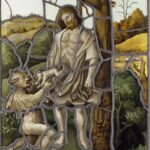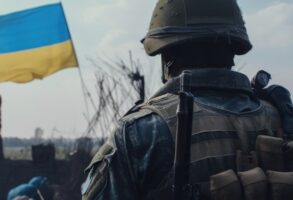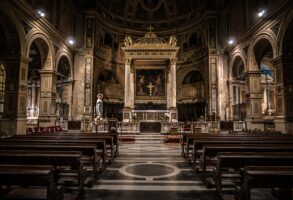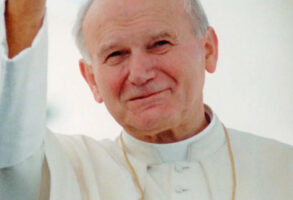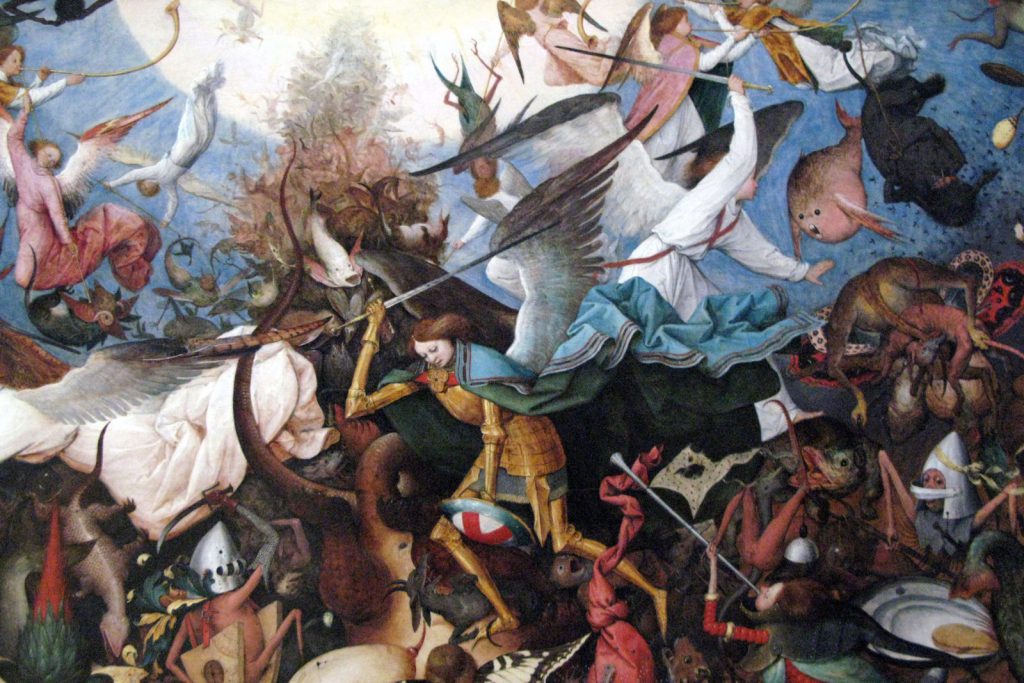
Published June 14, 2018
The Fragility of Order: Catholic Reflections on Turbulent Times
The following excerpt is reprinted from EPPC Distinguished Senior Fellow George Weigel’s new book The Fragility of Order: Catholic Reflections on Turbulent Times, with permission from Ignatius Press.
INTRODUCTION
Things Coming Apart?
Not so long ago, Irish poet William Butler Yeats’ often-quoted lament about things falling apart and mere anarchy being loosed upon the world seemed rather exaggerated. Take the summer of 1991, for example.
On August 15, 1991, the Soviet Union disintegrated—remarkably, on the liturgical feast of the Assumption of the Blessed Virgin Mary, celebrated the same day by both the Christian East and the Christian West. Two years earlier, during what history now knows as the Revolution of 1989, the Soviet external empire built by Lenin and Stalin self-liberated, led by Poland. Between 1989 and 1991, independence movements in the Baltic states, led by Lithuania, began dismantling the “Union of Soviet Socialist Republics”: Lenin’s and Stalin’s internal empire. The coup de grâce for the entire Soviet enterprise, arguably the greatest tyranny in human history, came when a hardline revolt against Soviet president Mikhail Gorbachev failed and the “republics” of the Soviet Union one by one detached themselves from the USSR’s Russian core.
And at that point, the Great Emergency ended: the civilizational crisis that began in 1914 and threatened to destroy the West (and, in its latter phases, the entire world) seemed to have been resolved in favor of the forces of freedom. Imperfect democracies had defeated a pluperfect tyranny; a “third wave” of democratization seemed poised to sweep the globe; free economies, unshackled from socialist-bureaucratic control, would liberate the world from gross poverty and deliver unprecedented wealth; new forms of international and transnational political organization, linking free societies in a thick network of collaborative efforts, would replace the old power games of world politics; “peace with honor”, which British prime minister Neville Chamberlain so vainly proclaimed in 1938, was at hand.
As for the United States, the blood and treasure it had invested in the Cold War seemed vindicated. America was the dynamo of world historical initiative. Deft American diplomacy led to the reunification of Germany and the creation of what looked to be a permanently stable, peaceful, and wealthy Europe. More creative diplomacy produced a major drawdown of nuclear weapons. A prominent intellectual proclaimed it the “end of history”, and the American people imagined that they could begin to enjoy a long-sought peace dividend, even as their high-tech military proved itself capable of maintaining the rudiments of a new world order in the First Gulf War.
While the world seemed on the brink of a new era of peace and prosperity, the Catholic Church—the world’s largest religious body, which had proven itself a powerful agent of liberation in the Revolution of 1989—seemed ready to provide this post–Cold War world with a compelling moral compass, even as it felt itself reenergized for its primary mission: the conversion of the world.
A brilliant pope, John Paul II, had ignited the revolution of conscience that made the nonviolent, political Revolution of 1989 possible. On May 1, 1991, he issued a striking encyclical, Centesimus Annus. Originally conceived as a centennial commemoration of Pope Leo XIII’s seminal 1891 social encyclical, Rerum Novarum, the stirring events in Europe throughout the 1980s led John Paul II to write Centesimus Annus as a prescription for the future—a future of freedom in which democratic politics and market-centered economies, guided by law and tempered by a vibrant public moral culture, would shape the human future in ways consonant with the inalienable dignity and value of every human being. Four years later, John Paul put that vision before the General Assembly of the United Nations, boldly claiming that the “tears of [the twentieth] century [had] prepared the ground for a new springtime of the human spirit.”
And the Church would contribute to that springtime by recovering its original self-understanding as a communion of missionary disciples. Thus, shortly before Centesimus Annus, on December 7, 1990, John Paul II issued another landmark encyclical, Redemptoris Missio (The Mission of the Redeemer). There, he taught that the Church did not have a mission, as if “mission” were one of a dozen things the Church did; rather, the Church is a mission, and everyone in the Church is a missionary, commissioned by baptism to help spread the Gospel throughout the world. Shortly afterward, John Paul began using the term “the New Evangelization” to express this contemporary recovery of the Church’s original purpose. Then, in drawing the Great Jubilee of 2000 to a close, the Pope challenged the entire Catholic world to leave the shallow waters of institutional maintenance and “put out into the deep” for a great catch of souls, following the Lord’s injunction in Luke 5:4 that led to the miraculous draught of fish.
A world poised to achieve all the great things imagined before World War I because order had been restored to global affairs after the seventy-seven years of the Great Emergency; an America imagining itself returned to the natural order of things, at peace with the world and beginning to feel the expansive economic effects of the IT revolution; a Church eager to offer humanity the healing truth of the Gospel and to make its unique contribution to building free and virtuous societies, because it had rediscovered its own “order” and purpose—it was a heady time indeed.
A quarter-century later, things look rather different. In fact, on the edge of the third decade of the twenty-first century and the third millennium, Yeats’ premonition of things coming unraveled seems increasingly prescient—in the world, in the American republic, and in the Church. And to continue to borrow images from the Irish poet, it is not at all certain what the many rude beasts slouching toward Bethlehem portend about the future of Catholicism, America, or the world. Order, it has become clear, is a very fragile thing; and order is especially vulnerable under the cultural conditions of a postmodern world unsure about its grasp on the truth of anything. Order is not self-maintaining. Order is an achievement, and it must be attained, over and again.
This is perhaps most obvious in terms of world affairs. If peace, as Saint Augustine taught, is the “tranquility of order”, the “order dividend” that might have been expected at the end of the Cold War turned out to be something of a chimera. The unfinished business of the First Gulf War was followed by the lethal crack-up of Yugoslavia, which was followed by largely ignored signals that jihadist Islam had the West, and particularly the United States, in its apocalyptic crosshairs—a fact that became unmistakably clear on September 11, 2001. That cataclysmic event led to wars in Afghanistan and Iraq, a debilitating world-weariness on the part of the American people, the reassertion of Russian power by a virtual dictator who never got the memo that the Cold War was over, a newly aggressive China flexing its muscles throughout East Asia, and so forth and so on, in a litany of disorder that seemed inconceivable in 1991—and that seemed ominously intractable a quarter-century later.
Order also rapidly unraveled in the United States: first, moral order, as the acids of postmodernist skepticism and relativism worked their way through the population; then, cultural order, as what philosopher Ernest Fortin once dubbed “debonair nihilism” became the default position in both high and popular culture; finally, political order. Solidity of character was no longer deemed a minimum prerequisite for high public office. Partisanship intensified, not least at the points where moral judgment and public policy intersected. Finally, in 2016, the country embarrassed itself before the world in a presidential campaign of unprecedented vulgarity.
As for the Church, the assumption that the pontificates of John Paul II and Benedict XVI had restored a sufficient measure of order— understood as evangelical purpose—after the upheavals of the post Vatican II period was dramatically falsified by the quick (and in some instances, cheerful) resumption of intra-Catholic conflict during the first years of Pope Francis. In the apostolic exhortation Evangelii Gaudium (The Joy of the Gospel), the Argentine pope declared a Church “permanently in a state of mission” the hope of his heart and the grand strategy of his pontificate, in a line of continuity with John Paul II’s New Evangelization. But Francis seemed unpersuaded by the claim, and the evidence, that the living, evangelically dynamic parts of the world Church were those that had embraced Catholicism in full, and that the dying parts of the Church were those in thrall to “Catholic Lite”. The result, exemplified by the Synods of 2014 and 2015 and the raucous global debate over the post-synodal apostolic exhortation Amoris Laetitia (The Joy of Love), was not an intensification of missionary fervor but a deterioration into discord and disunity.
The essays collected here, originally written over the past two decades, have been revised for this volume. Each attempts to analyze one or another aspect of the unraveling that so many sense in these first decades of the third millennium; some even propose first steps toward a resolution of that unraveling. But the primary concern here is one of diagnosis, not prescription.
These reflections may seem, at first blush, to cover a lot of disconnected, noncontiguous territory. The common thread among them is the twinned conviction that has animated my thought and work as a theologian at the crossroads of moral reasoning and public life. The first conviction is that both American democracy and the future of freedom in the world are jeopardized when the deep truths inscribed into the world and into us by what the American Founders called in the Declaration of Independence “the Laws of Nature and of Nature’s God” are ignored—or worse, dismissed as irrational prejudice. The related, or twinned, conviction is that it is the Church’s task, through its evangelical mission and its witness in the public square, to teach and embody those deep truths, both for the healing of broken humanity and to provide some sort of grammar for an orderly public debate over the human future.
In turbulent times, the Christian does well to keep in mind that, however much mankind may be making a mess of things, the truth announced by the Lord when he first sent the Twelve out on mission remains the truth: “The kingdom of heaven is at hand” (Mt 10:7). And while the Church may feel itself buffeted by the cultural exhaust fumes of a West now reckoning with the grave intellectual and moral damage it suffered before and during the Great Emergency, Catholics should also remember that deep spiritual and moral conviction can leverage change for the better. In Lumen Gentium 9, writing at a more optimistic moment, the Fathers of the Second Vatican Council nonetheless offered the Church of this moment an important lesson when they described the nature of the Church and its place in the world in these stirring terms:
“Behold the days shall come saith the Lord, and I will make a new covenant with the House of Israel, and with the house of Judah…. I will give my law in their bowels, and I will write it in their heart, and I will be their God, and they shall be my people…. For all of them shall know Me, from the least of them even to the greatest, saith the Lord” ( Jer. 31:31–34). Christ instituted this new covenant, the new testament, that is to say, in His blood (cf. 1 Cor. 11:25), calling together a people made up of Jew and gentile, making them one, not according to the flesh but in the Spirit. This was to be the new People of God. For those who believe in Christ, who are reborn not from a perishable but from an imperishable seed through the word of the living God (cf. 1 Pt. 1:23), not from the flesh but from water and the Holy Spirit (cf. Jn. 3:5–6), are finally established as “a chosen race, a royal priesthood, a holy nation, a purchased people … who in times past were not a people, but are now the people of God” (1 Pt. 2:9–10)….
So it is that that messianic people, although it does not actually include all men, and at times may look like a small flock, is nonetheless a lasting and sure seed of unity, hope and salvation for the whole human race. Established by Christ as a communion of life, charity and truth, it is also used by Him as an instrument for the redemption of all, and is sent forth into the whole world as the light of the world and the salt of the earth (cf. Mt. 5:13–16).
Those who believe that to be the truth may have cause for concern about the state of affairs in the world, the American republic, and the Church. But believing that to be the truth, they have no cause for despair, and they have no choice but to put out into the deep in a mission of truth-telling, healing, and conversion.
George Weigel is Distinguished Senior Fellow of Washington, D.C.’s Ethics and Public Policy Center, where he holds the William E. Simon Chair in Catholic Studies.




